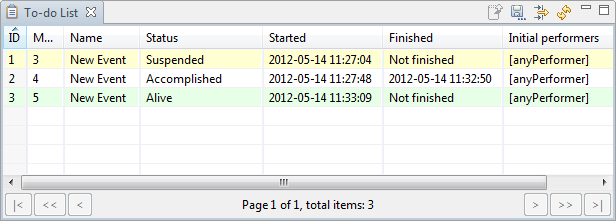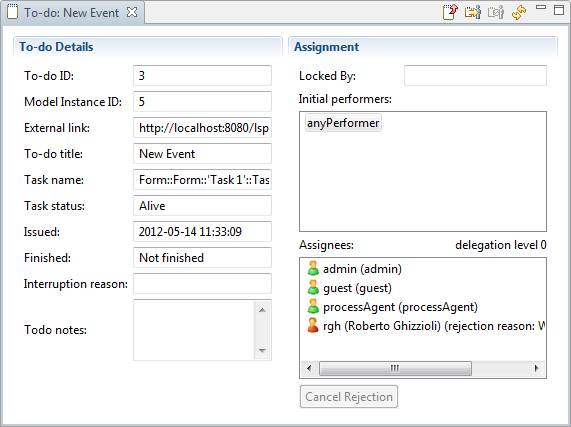
To manage To-Dos generated by the LSPS Server and to open their details use the To-Do List view.
The view contains the following To-Do details:
Status: current to-do execution status (a to-do can be Alive, Accomplished, or Interrupted; Alive to-dos are highlighted)
Note: If its parent model instance is suspended, a to-do is also in the suspended status; however, this is not a to-do status by itself.
You can copy the table rows to the clipboard by selecting them and pressing Ctrl + C and export and import XML to-do states.

You can do the following when managing to-dos:
The accessibility of the actions can be restricted by user security rights.
For explanation of the concepts behind the actions, refer to To-Dos.
Important: The to-do management mechanism are provided as a base for custom to-do management features and are in no way to be considered production-ready.
A To-Do Detail view contains detailed information about a particular to-do and allows you to perform further actions available for the to-do, such as delegation, undo delegation, and cancel rejection.
To open a to-do detail view, click a to-do entry in the To-do List view.
A to-do detail view contains two areas:
Initial performers: set of roles (or persons), who are entitled to perform the to-do as defined in the parent model
Note: This set does not include substitutes or delegates, who may have the to-do assigned by initial performers.
From the view toolbar in the upper right corner of a to-do detail view, you can perform allocation related actions (for more information refer to Escalation, and Delegation.

An orphaned to-do is a to-do, which cannot be seen by any front-end application user, possibly as a result of such actions as escalation, delegation, etc: If a to-do was rejected by all assigned persons, or delegated to persons with insufficient security rights.
You can search for such to-dos from the To-Do List view: the view toolbar, click Filter  , and check Orphaned to-dos only.
, and check Orphaned to-dos only.
You can delegate a to-do from the Management perspective: Click the Delegate (  ) button in the toolbar of the To-Do Detail view and define the delegates. Delegates and the current delegation level are then displayed in the Assignees area of the respective to-do detail view.
) button in the toolbar of the To-Do Detail view and define the delegates. Delegates and the current delegation level are then displayed in the Assignees area of the respective to-do detail view.
To undo delegation, click the Undo Delegate  button in the toolbar of the To-Do Detail view.
button in the toolbar of the To-Do Detail view.
Escalation sends an escalation Signal to the server while keeping the to-do locked.
Important: The underlying Model is expected to catch and process it as appropriate with a Signal Catch Intermediate Event or Signal Start Event: The LSPS Server does not handled this Escalation signal by default.
To send such an escalation signal from a to-do from the Management perspective, click the Escalate (  ) button in the toolbar of the To-Do Detail view or select the to-dos in the To-Do List and click Escalate.
) button in the toolbar of the To-Do Detail view or select the to-dos in the To-Do List and click Escalate.
Note that this escalation mechanism is not related to the Escalation of the GO-BPMN Modeling Language.
Rejection allows a front-end user to reject a to-do: when they do so, they are excluded from its assignees. You can cancel the rejection, so if the to-do is not locked by other users, it will reappear in their to-do list.
In the Assignees box of a to-do detail view, Assignees, who have previously rejected the to-do, are indicated by a red assignee icon. The rejection reason provided by the assignee is shown next to their icon and name. You can cancel the rejection and reallocate the to-do to the assignee from the To-Do Detail view.

Click the to-do reset  button at the top of the to-do detail to reset a to-do. Reset erases the data in a saved to-do but the to-do remains locked. This feature is useful if the data used by the saved to-do have changed.
button at the top of the to-do detail to reset a to-do. Reset erases the data in a saved to-do but the to-do remains locked. This feature is useful if the data used by the saved to-do have changed.
Click the to-do reassign  button at the top of the to-do detail and define the roles and persons who should become new initial performers.
button at the top of the to-do detail and define the roles and persons who should become new initial performers.
If you want to modify runtime data of a to-do that is not persisted in the database, you can do so directly in the raw XML of the model instance. Note that if you modify data that is persisted in the database, the data is changed only in the XML and remains unchanged in the database.
Note that the To-Do import and export features are subject to the security right Todo:Write_All
To export or import the model instance XML with the to-do data, do the following:
Important: Importing a corrupted XML can cause the system to fail to work with the to-do.